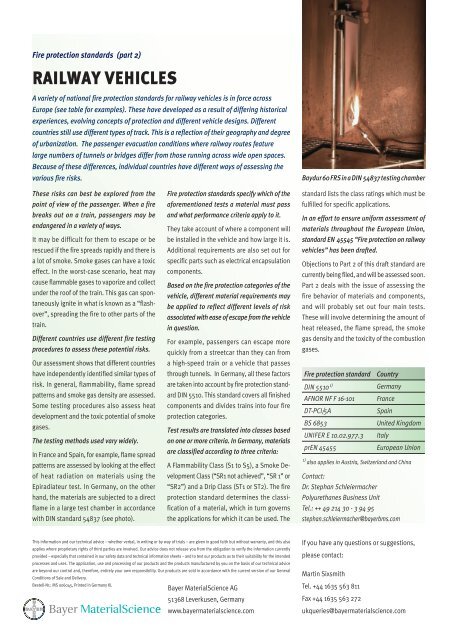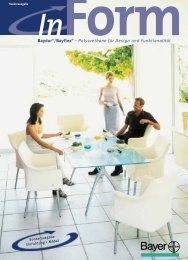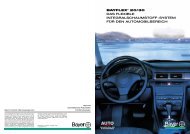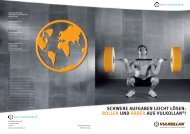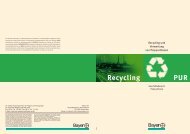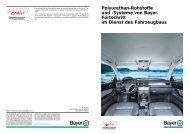Here - Polyurethanes - Bayer
Here - Polyurethanes - Bayer
Here - Polyurethanes - Bayer
You also want an ePaper? Increase the reach of your titles
YUMPU automatically turns print PDFs into web optimized ePapers that Google loves.
Guide To <strong>Polyurethanes</strong><br />
Fire protection standards (part 2)<br />
RAILWAY VEHICLES<br />
A variety of national fire protection standards for railway vehicles is in force across<br />
Europe (see table for examples). These have developed as a result of differing historical<br />
experiences, evolving concepts of protection and different vehicle designs. Different<br />
countries still use different types of track. This is a reflection of their geography and degree<br />
of urbanization. The passenger evacuation conditions where railway routes feature<br />
large numbers of tunnels or bridges differ from those running across wide open spaces.<br />
Because of these differences, individual countries have different ways of assessing the<br />
various fire risks.<br />
These risks can best be explored from the<br />
point of view of the passenger. When a fire<br />
breaks out on a train, passengers may be<br />
endangered in a variety of ways.<br />
It may be difficult for them to escape or be<br />
rescued if the fire spreads rapidly and there is<br />
a lot of smoke. Smoke gases can have a toxic<br />
effect. In the worst-case scenario, heat may<br />
cause flammable gases to vaporize and collect<br />
under the roof of the train. This gas can spontaneously<br />
ignite in what is known as a “flashover”,<br />
spreading the fire to other parts of the<br />
train.<br />
Different countries use different fire testing<br />
procedures to assess these potential risks.<br />
Our assessment shows that different countries<br />
have independently identified similar types of<br />
risk. In general, flammability, flame spread<br />
patterns and smoke gas density are assessed.<br />
Some testing procedures also assess heat<br />
development and the toxic potential of smoke<br />
gases.<br />
The testing methods used vary widely.<br />
In France and Spain, for example, flame spread<br />
patterns are assessed by looking at the effect<br />
of heat radiation on materials using the<br />
Epiradiateur test. In Germany, on the other<br />
hand, the materials are subjected to a direct<br />
flame in a large test chamber in accordance<br />
with DIN standard 54837 (see photo).<br />
Fire protection standards specify which of the<br />
aforementioned tests a material must pass<br />
and what performance criteria apply to it.<br />
They take account of where a component will<br />
be installed in the vehicle and how large it is.<br />
Additional requirements are also set out for<br />
specific parts such as electrical encapsulation<br />
components.<br />
Based on the fire protection categories of the<br />
vehicle, different material requirements may<br />
be applied to reflect different levels of risk<br />
associated with ease of escape from the vehicle<br />
in question.<br />
For example, passengers can escape more<br />
quickly from a streetcar than they can from<br />
a high-speed train or a vehicle that passes<br />
through tunnels. In Germany, all these factors<br />
are taken into account by fire protection standard<br />
DIN 5510. This standard covers all finished<br />
components and divides trains into four fire<br />
protection categories.<br />
Test results are translated into classes based<br />
on one or more criteria. In Germany, materials<br />
are classified according to three criteria:<br />
A Flammability Class (S1 to S5), a Smoke Development<br />
Class (“SR1 not achieved”, “SR 1” or<br />
“SR2”) and a Drip Class (ST1 or ST2). The fire<br />
protection standard determines the classification<br />
of a material, which in turn governs<br />
the applications for which it can be used. The<br />
This information and our technical advice – whether verbal‚ in writing or by way of trials – are given in good faith but without warranty‚ and this also<br />
applies where proprietary rights of third parties are involved. Our advice does not release you from the obligation to verify the information currently<br />
provided – especially that contained in our safety data and technical information sheets – and to test our products as to their suitability for the intended<br />
processes and uses. The application‚ use and processing of our products and the products manufactured by you on the basis of our technical advice<br />
are beyond our control and‚ therefore‚ entirely your own responsibility. Our products are sold in accordance with the current version of our General<br />
Conditions of Sale and Delivery.<br />
Bestell-Nr.: MS 006045, Printed in Germany KL<br />
<strong>Bayer</strong> MaterialScience AG<br />
51368 Leverkusen, Germany<br />
www.bayermaterialscience.com<br />
Baydur 60 FRS in a DIN 54837 testing chamber<br />
standard lists the class ratings which must be<br />
fulfilled for specific applications.<br />
In an effort to ensure uniform assessment of<br />
materials throughout the European Union,<br />
standard EN 45545 “Fire protection on railway<br />
vehicles” has been drafted.<br />
Objections to Part 2 of this draft standard are<br />
currently being filed, and will be assessed soon.<br />
Part 2 deals with the issue of assessing the<br />
fire behavior of materials and components,<br />
and will probably set out four main tests.<br />
These will involve determining the amount of<br />
heat released, the flame spread, the smoke<br />
gas density and the toxicity of the combustion<br />
gases.<br />
Fire protection standard<br />
DIN 5510 1)<br />
AFNOR NF F 16-101<br />
DT-PCI/5A<br />
BS 6853<br />
UNIFER E 10.02.977.3<br />
prEN 45455<br />
Country<br />
Germany<br />
France<br />
Spain<br />
United Kingdom<br />
Italy<br />
European Union<br />
1) also applies in Austria, Switzerland and China<br />
Contact:<br />
Dr. Stephan Schleiermacher<br />
<strong>Polyurethanes</strong> Business Unit<br />
Tel.: ++ 49 214 30 - 3 94 95<br />
stephan.schleiermacher@bayerbms.com<br />
If you have any questions or suggestions,<br />
please contact:<br />
Martin Sixsmith<br />
Tel. +44 1635 563 811<br />
Fax +44 1635 563 272<br />
ukqueries@bayermaterialscience.com


